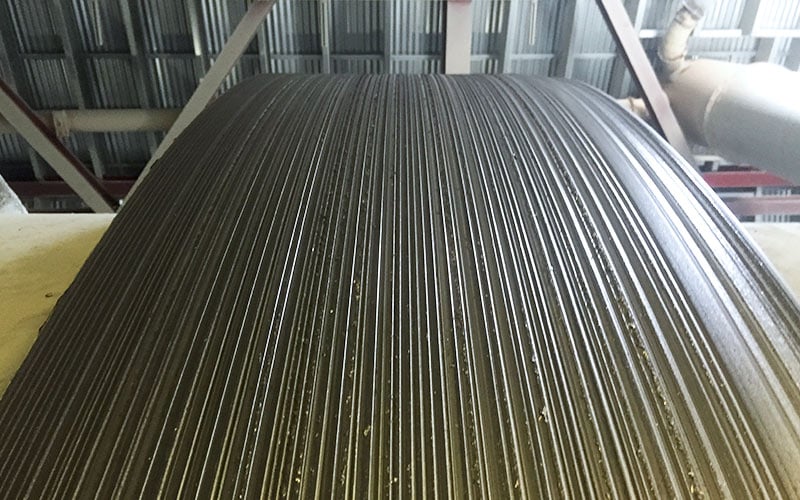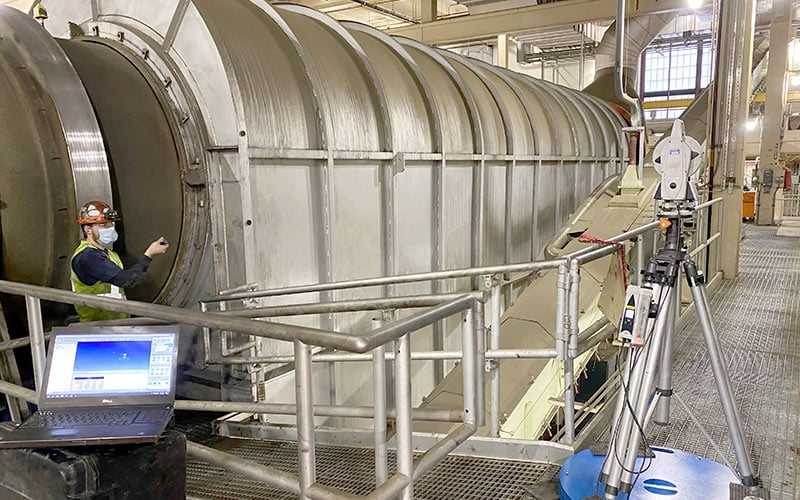Maximizing the reliability and service life of a rotary dryer is the focus of many plant managers. One of the most important, but most overlooked aspects of rotary drum maintenance is ensuring proper alignment, or the positioning of the drum on its bases.
Why Rotary Dryer Alignment is Critical
Alignment is perhaps one of the most influential aspects of a rotary dryer’s service life. Proper alignment ensures the drum is structurally stable and not experiencing undue mechanical stress due to uneven load distribution paired with constant motion and heat stressors.
When a rotary dryer falls out of alignment, its mechanical components, as well as the drum shell, can be quickly affected, making misalignment one of the most common reasons a drum experiences damage or premature failure. The longer the dryer remains in a state of misalignment, the more severe and widespread the damage will be.
Resulting damage can come in many forms, from failed trunnion bearings to worn tires and trunnions, and in severe cases, a distorted drum shell caused by flexing.
Why Misalignment Occurs
While a rotary dryer is always (or should have been) properly aligned at the time of commissioning, a number of factors can cause the dryer to fall out of alignment over time, necessitating realignment. Common reasons for which misalignment occurs include:
- If bases have settled
- If tires and/or trunnions have been ground/resurfaced beyond 10% of their original diameter
- If process conditions (loading, capacity, temperatures, material characteristics, etc.) have changed
- If the dryer has undergone any major repairs or component replacements
- If proper “float” between thrust rollers has not been properly maintained
- If trunnion bases have been excessively skewed or shimmed
- A humid operating environment
- Poor housekeeping or excessive dust, particularly in and around trunnion pits
Signs of Rotary Dryer Misalignment
Misalignment can reveal itself in many ways. Common indications that a dryer has fallen out of alignment include:
- Chattering, grinding, or other abnormal sounds
- Visual wear or damage to tires and/or trunnion wheels
- Visual wear or damage to pinion and/or girth gears
- Visual wear or damage to thrust rollers
- Improper contact between tires and trunnions, at point of gear mesh, or around thrust rollers
As these signs can also be indications of other issues, it’s best to have the OEM or a qualified service provider perform a rotary dryer audit to identify any underlying problems. Because misalignment can be caused by a variety of factors, this also helps to establish the root cause so that once the dryer is realigned, wear will not resume because of an unresolved issue.

This type of grooved tire wear could be an indication of a misaligned drum.
Alignment Methods for Rotary Dryers
When it comes to any type of rotary drum equipment, there are two primary approaches to alignment:
Manual Alignment
The traditional approach to alignment consists of a trained technician manually measuring various points of the drum to establish its coordinates in relation to the proper axis of alignment. The technician then takes those coordinates and calculates the base adjustments needed to bring the drum back to alignment.
The manual approach to alignment is still widely employed, but requires careful and vigilant attention to detail to ensure accuracy. It may also require surrounding equipment to be moved for improved access to the drum for taking measurements. This method continues to be replaced by a faster, more accurate approach: laser alignment.
Laser Alignment
While the traditional approach to alignment relies on manual measurements and calculations, modern laser alignment techniques largely automate this process, removing the potential for human error.
A laser tracking system is placed at various points along the drum to measure and record coordinates, as well as diameter and face profiles of tires and trunnions. Because the system relies on laser beams, surrounding equipment and infrastructure (pipes, etc.) need not be moved. Accompanying software uses the gathered coordinates to develop a 3D spatial map of the unit and calculate the required base adjustments needed for alignment.
The laser alignment method significantly improves the speed and precision with which realignments are carried out.

A FEECO Customer Service Engineer utilizes the laser alignment system to realign an indirect rotary dryer.
What the Alignment Process Entails
The alignment process and its duration may vary, depending not only on the chosen method, but also based on the provider, as well as a number of other factors.
FEECO begins the process by observing the drum in operation and confirming a misalignment issue, along with identifying any other underlying problems.
Once misalignment has been confirmed, the Customer Service Engineer sets up the laser tracking system to establish the existing coordinates in relation to the proper axis and the adjustments needed.
Depending on the extent of misalignment and where adjustment is needed, the engineer will then make adjustments to ensure all four wheels are square and true to each other on the same slope. This is followed by further shimming or skewing (or in some cases, both) of trunnion bearings as needed to bring the drum into proper alignment.
After the trunnion wheel alignment process, the FEECO service technician/engineer can then “train” the drum, ensuring proper float between thrust rollers. This prevents the dryer from riding too hard against either the uphill or downhill thrust roller.
Advantages to a FEECO Rotary Dryer Alignment
As the industry leader in manufacturing and maintaining custom rotary dryers, a FEECO alignment offers a number of advantages:
Fast, Simple, and Accurate
Our extensive expertise, paired with our state-of-the-art laser alignment system quickly achieves precision alignment with minimal hassle.
A Wealth of Data
The Customer Service Engineer can work with operators and maintenance personnel while on site to address any questions or issues they may have. At the conclusion of each project, we provide a detailed report with our findings, including the state of the dryer before alignment, any adjustments made, and recommendations for future maintenance. This provides valuable benchmarking data for future maintenance planning.
Additional Rotary Dryer Repairs
In addition to alignment, the Customer Service Engineer can perform a number of other inspections and repairs as needed while on site. This might include drum shell thickness checks, coupling and shaft alignments, seal inspections, backlash evaluation, and burner inspection.
Conclusion
Proper alignment is an essential aspect in maximizing rotary dryer service life and minimizing unnecessary maintenance costs and downtime. FEECO is the industry’s preferred provider for alignments and other rotary dryer services that will keep your dryer running its best. To schedule an inspection or dryer alignment, contact us today!



